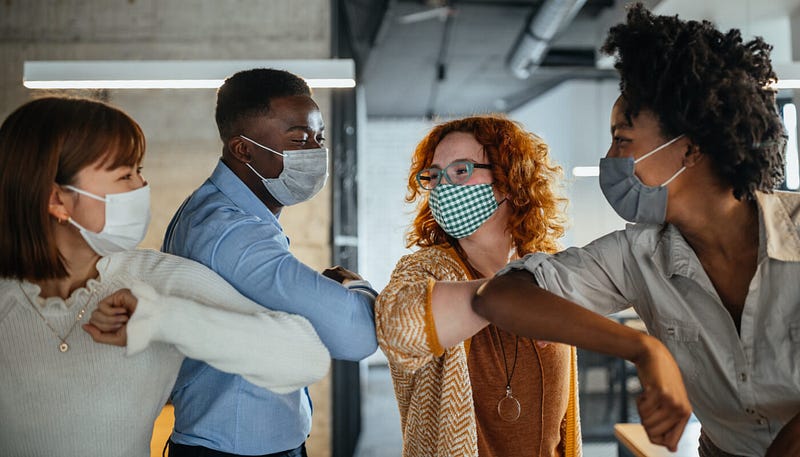Want to Stress-Proof Your Office? Let Workers Show Their True Colors
Workplace friendships suffered during the pandemic, but trust mitigated the damage, according to new research.
Based on the research of Steven Gray and David Harrison

How can workers maintain their workplace relationships when there’s no workplace? Employees were forced to confront that question during the spring of 2020, when the COVID-19 pandemic abruptly shut down offices across America.
As they struggled with the logistical challenges of working remotely, they also faced social challenges, say two researchers at Texas McCombs. In a new study, observing an organization before and after COVID closures, they found cutbacks in two kinds of on-the-job relationships:
· Advice ties, which involve giving work-related guidance or resources.
· Friendship ties, based on personal bonds rather than work needs.
But they also found a partial antidote. Workers who believed they could be their authentic selves around co-workers held on to more office friendships after their offices went virtual. The researchers name the attitude “anticipated inclusion.”
“I’m getting signals about whether or not they will value me for who I am, not just what resources I have to offer,” says David Harrison, management professor. “I’m going to get connected to those people.”
Says Steven Gray, assistant management professor: “Anticipated inclusion is a kind of armor in a relationship that helps protect it from stress and forces that might otherwise dissolve it.”
By actively promoting that attitude among their workers, companies can lessen the drawbacks of remote work, Harrison adds. “Anticipated inclusion is essentially anticipated trust. Companies can create conditions that facilitate trust and friendships.”
Running on Relationships
When the study began, pre-COVID, its goal was to trace social networks among new workers in an organization.
“Organizations don’t run on charts,” Harrison says. “They run on relationships. We wanted to explore the portfolios of social relationships that new entrants form and how they maintain, drop, or add them over time.”
With management doctoral candidate Jake Jo, Harrison and Gray followed 145 incoming MBA students at McCombs. Like new hires, Harrison says, they had to quickly create social networks in settings that threw teams together across racial and other demographic lines.
The students filled out surveys before and after the fall 2019 semester. For each of the two surveys, from a list of classmates, they marked which ones they spoke with about schoolwork and which ones they talked to about personal matters. They also rated how accepted they felt by peers.
After COVID hit and classes moved online, the researchers saw a new opportunity: to investigate how an outside shock altered networks inside an organization. They administered a third survey, adding a measure of emotional exhaustion.
Stress vs. Acceptance
The results showed the pandemic took tolls on both kinds of relationships. A measure of advice ties dropped 58%. Friendship ties fell more sharply: 76%. People with higher levels of emotional exhaustion cut back relationships even more.
“There weren’t a set of friends out there who could independently help you get through this thing, because they were all going through the same stress at the same time,” Harrison explains. So people felt less motivation to reach out to help others.
Cross-racial friendships suffered the most, he says, because of homophily: the psychological impulse to bond more closely with people who are similar in some way, such as ethnic identity.
But anticipated inclusion countered those effects, at least for friendships. People with high levels were 22% more likely to maintain friendship ties than those with low levels. They were also more likely to keep friendships with people of other races.
Those findings spotlight the value of helping workers feel personally accepted, says Gray. “The more authentic, intimate friendships endured, because they had useful value in coping with the shock of the pandemic.”
Fostering Friendship
The lesson, the researchers conclude, is to build an inclusive culture before a shock strikes. It can buffer organizational networks against stresses such as a merger, an acquisition, or a bankruptcy, as well as a pandemic.
“What matters is whether these relationships are built in the right way in the first place,” Gray says. “When the time comes for coping, those relationships are already there.”
He suggests providing office spaces for spontaneous encounters, as well as forums such as newsletters for sharing personal stories and milestones. Outside group activities like building a Habitat for Humanity house can also encourage workers to open up to one another.
Such informal gatherings let workers discover unusual interests they share, like a hobby or favorite travel destination, Harrison says. “It has to be an uncommon commonality. We’re sharing something that’s unique about us and saying, hey, we both experienced that same thing.”
Strategies for fostering personal connections may become even more important after the pandemic ends, he adds, when many workers may choose to stay remote.
“A lot of what we know about how to manage people may change dramatically,” Harrison says. “We need to learn more about how to build camaraderie and community among people when they don’t get to spend physical time together. Human beings are not built for virtual relationships.”
“The Ties That Cope? Reshaping Social Connections in Response to Pandemic Distress” is published in the Journal of Applied Psychology.
Story by Steve Brooks


